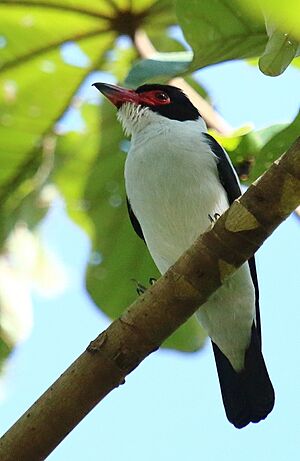Black-tailed tityra facts for kids
Quick facts for kids Black-tailed tityra |
|
|---|---|
 |
|
| A black-tailed tityra in Trinidad. | |
| Conservation status | |
| Scientific classification | |
| Genus: |
Tityra
|
| Species: |
cayana
|
 |
|
| Synonyms | |
|
Lanius cayanus Linnaeus, 1766 |
|
The black-tailed tityra (Tityra cayana) is a cool medium-sized bird found in the warm, tropical parts of South America. These birds are a bit special because scientists used to group them with other bird families like cotingas or tyrant flycatchers. But now, most experts agree they belong in their own family called Tityridae.
Contents
About the Black-tailed Tityra
The black-tailed tityra is a strong bird with a short tail and a long bill that has a hook at the end. It's about 20–22 centimetres (7.9–8.7 in) long, which is about the size of a small ruler. It weighs around 60–70 grams (2.1–2.5 oz), which is like a small apple.
What They Look Like
Male black-tailed tityras are mostly dull white on their bodies. Their tail feathers, main wing feathers, and a cap on their head (that goes below their eyes) are black. Some of their wing feathers are silvery grey.
Female tityras have dark brown colors instead of black on their wings and tail. They also have some brown patterns on their head, back, and belly.
Both male and female tityras have a patch of rosy-red skin around their eyes. Their bill is red at the base with a black tip. Their eyes and feet are dark.
Their Calls
This bird makes a buzzing, short call that sounds like ed, rek, urd, or wenk. They also make a double beeza-buzza sound and a triple weenk, weenk, weenk. They often call more when they are flying than when they are sitting still.
Where They Live and What They Eat
Black-tailed tityras live all year round in places like forest edges, new forests growing back, and shady areas in plantations. They usually live below 500 metres (1,600 ft) (about 1,600 feet) above sea level, but sometimes they can be found as high as 1,100 metres (3,600 ft) (about 3,600 feet).
Their Daily Life
You'll most often see black-tailed tityras in pairs, or sometimes alone or in small groups. They don't like other birds much and will try to chase them away.
They often sit in open spots where they can be easily seen. They love to eat medium-sized fruits. They pick food from plants or grab it while hovering in the air. While they do catch some large insects, these are mostly for feeding their young. Adult tityras mainly eat fruit. They are important for spreading seeds of plants like the Cabralea canjerana tree.
These birds usually don't join big groups of different bird species that feed together, even when they are feeding their babies. They prefer to find insects on their own, high up in the trees.
Family Life
The main time for black-tailed tityras to have babies is usually from November to March. However, you might find them nesting almost any time of the year in some places. For example, in parts of Colombia and Ecuador, they've been seen breeding in June and July too. This might mean they don't have a strict breeding season, or they might even have two sets of babies in a year.
Their nest is usually several meters (many feet) above the ground in a tree hole. This could be an old woodpecker nest or the top of a dead palm tree. The eggs are buff-colored with brown marks and are laid on a bed of dry leaves and small twigs. They likely lay three eggs, but the exact number isn't always known.
Only the female bird sits on the eggs to keep them warm. This takes almost three weeks until the chicks hatch. But once the babies are born, both parents help feed them. The young birds are believed to stay in the nest for at least three weeks, maybe even a month, before they are ready to fly.
Conservation Status
The black-tailed tityra is sometimes a host for the brood parasitic shiny cowbird. This means the cowbird lays its eggs in the tityra's nest, and the tityra raises the cowbird chicks.
This bird is quite common across its large home range and lives in many national parks and other protected areas. Because of this, the IUCN (International Union for Conservation of Nature) considers it a species of least concern. This means it's not currently in danger of disappearing.



